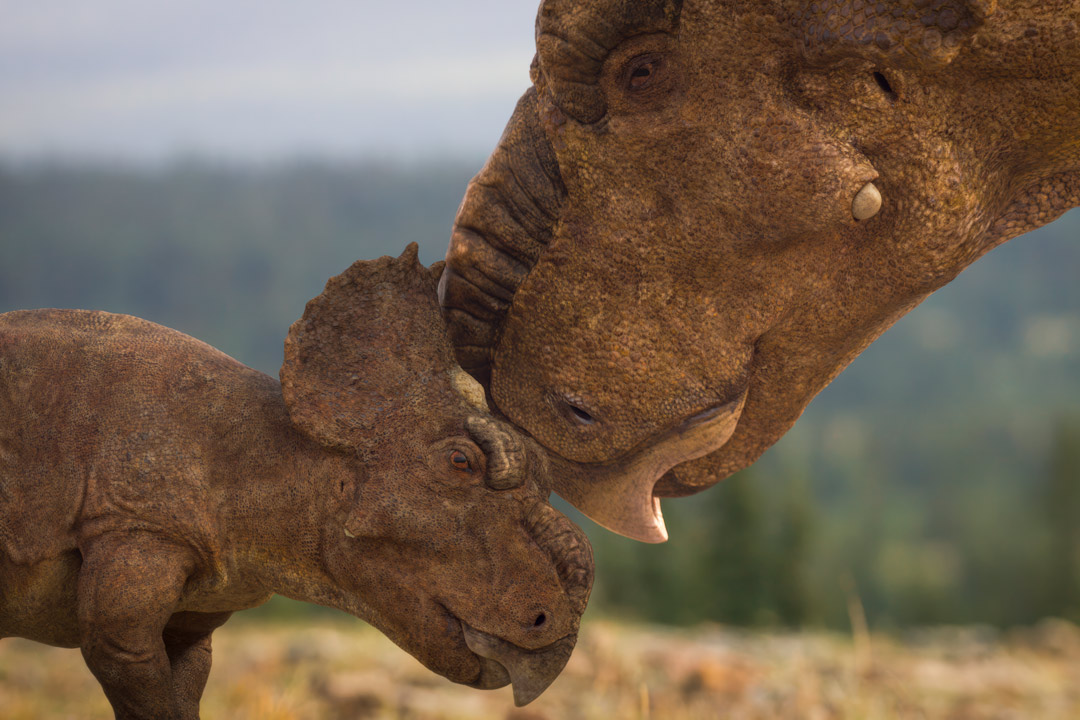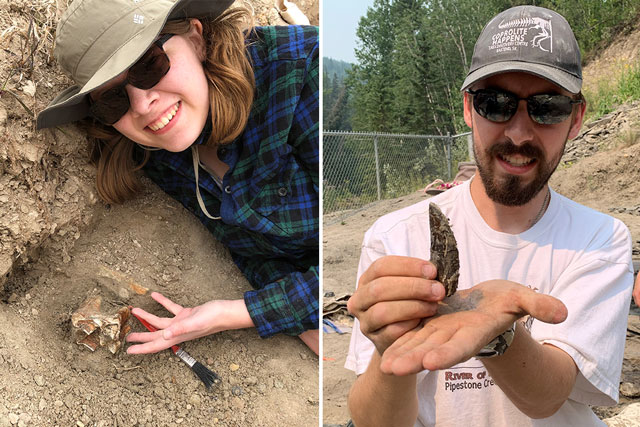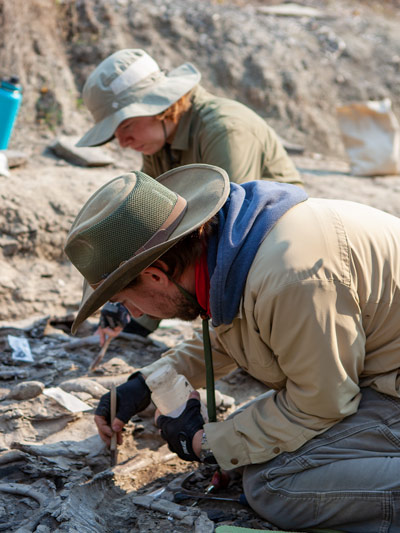
USask students featured in new Walking with Dinosaurs series
Paleontologists Jack Milligan and Kaitlin Lindblad appear in an episode of the celebrated series, which returns this summer
By Chris Putnam
Two USask paleontology students are part of the revival of one of the world’s most popular scientific documentary TV series.
Jack Milligan and Kaitlin Lindblad, who have both since graduated with their Master of Science degrees in geological sciences, filmed their parts in the BBC/PBS-produced series at a dig site in Alberta while they were USask students in fall 2023.
Walking with Dinosaurs premieres in Canada Aug. 26 on BBC Earth.
“It was surreal. It was really cool to be able to do paleontology work and be a part of this television show simultaneously, and have the crew feed off our excitement,” said Milligan (BSc’21, MSc’24). “Because we love being out there. Paleontology is the coolest job that anyone could ever have, in my opinion.”

Walking with Dinosaurs uses the latest visual effects technology to recreate the lives and stories of prehistoric animals in the style of a nature documentary. Unlike the original series, which released 25 years ago, the 2025 revival adds modern-day sequences with actual paleontologists at dig sites around the world.
Milligan and Lindblad were invited to be part of one of these shoots by Dr. Emily Bamforth (PhD), curator at the Philip J. Currie Dinosaur Museum and an adjunct professor in the Department of Geological Sciences in USask’s College of Arts and Science. Bamforth was a co-supervisor of both students and she features prominently in the new TV series.
“I said, ‘Yes, please. There’s no question,’” said Lindblad (MSc’24), whose graduate studies were co-supervised by USask geological sciences professor Dr. Gabriela Mángano (PhD). “We weren’t given that much information, but we heard Walking with Dinosaurs and that basically sold us.”
Lindblad and Milligan both grew up watching the original Walking with Dinosaurs in the early 2000s and consider it a major factor in their decisions to become paleontologists.
“I watched it religiously when I was a kid. I watched it so many times that I actually had to buy the DVD version because I’d rewound the (VHS) tape too much,” said Milligan, whose graduate studies were supervised by Bamforth, Mángano and geological sciences professor Dr. Luis Buatois (PhD).
The USask students traveled to the Pipestone Creek Pachyrhinosaurus bonebed near Grande Prairie, Alta., where a TV crew filmed them and other paleontologists—led by Bamforth—for a week doing some of their usual work at the site: uncovering fossils, making 3D maps of the bonebed and more.
Bamforth and the USask students appear in episode five of the series, which tells the story of a herd of pachyrhinosaurs—cousins of Triceratops—on a dangerous migration. The Pipestone Creek site is a mass grave of pachyrhinosaurs, their fossilized bones so cluttered that it is impossible to tell which bones belong to each individual.
“It’s basically a dinosaur omelette at this point. So something must have happened to break up all their bodies and jumble up their bones,” said Milligan.
The leading theory is that a catastrophic flash flood swept away much of the herd. This event will be dramatized in Walking with Dinosaurs.
The TV crew was present to record some real-life discoveries by the paleontologists. At one point during the shoot, the team uncovered a fossilized rib with a bone callus: evidence of a pachyrhinosaur that healed from a serious injury. This dinosaur’s story will also be brought to life in the episode.
“The site we were at is a really good site to do this, because it’s not really a question of if we’re going to find bones that day—it’s how many are we going to take out today, because it’s a really dense bonebed. There’s between 100 and 300 bones per square metre at this site,” said Milligan.

Lindblad and Milligan had a chance to preview the episode and were impressed at the accuracy of the animated dinosaurs’ looks, sounds and movements.
“They are really good reconstructions and some of the best I’ve seen on television. So I’m very happy with them,” said Lindblad, who has experience recreating the looks of living dinosaurs as a paleoartist.
Lindblad currently works as a summer assistant at the University of Regina and the Royal Saskatchewan Museum, while Milligan is working as a research assistant in the USask geological sciences department.
Both recent USask grads hope the TV series gets audiences excited about paleontology.
“Hearing that I was going to be a part of Walking with Dinosaurs really gave me this overwhelming sense of joy and responsibility,” said Milligan. “And I just knew that whatever I did, I hoped that I would inspire some kid somewhere to become a paleontologist, because that’s what the original show did for me.”
“Twenty-five years ago, the standard paleontologist was your guy in a cowboy hat—kind of the Alan Grant, Indiana Jones type of image,” said Lindblad. “But you look at this cast and crew, you see people from all walks of life in the show—all different backgrounds, all different interests, all different demographics—and it shows you that anybody can be interested in this. Anybody can become a paleontologist.”


